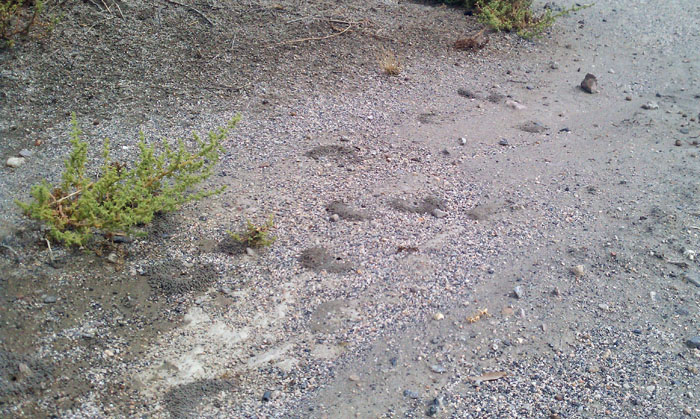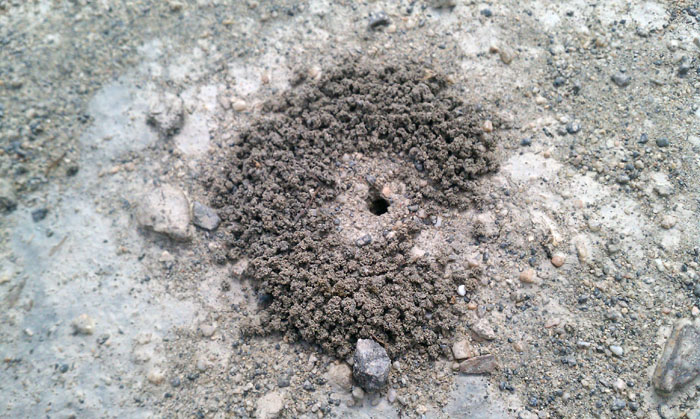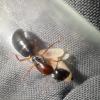Come on wook, not every ant can be red and black.
Cute though. How big are those nanitics anyways?
I would guess about 5.5 mm.

Come on wook, not every ant can be red and black.
Cute though. How big are those nanitics anyways?
I would guess about 5.5 mm.
Wow. That is bigger than I originally thought.
How large is that queen? She must be around 10-12mm.
"Always do right. This will gratify some people, and astound the rest." -- Samuel Clemens
That sounds about right. 11 would be my guess.
Update 12-7-2013
The forth worker eclosed today. ![]()
Come on wook, not every ant can be red and black.
Well, not red and black but black and red! ![]()
...:::]|wook|[:::...
Update 12-24-2013
The colony has 5 workers now, 4 big larvae, and a new batch of eggs.
Update 12-27-2013
Ok, all of those alates I found much later have been up in the cupboard all this time. The other day I looked them all over and didn't see anything but eggs; many of them had nothing at all. Well today I just noticed that two of the dealates actually each have one small larva in with all their eggs. I gave these two some food and placed them back in a spot where they won't be disturbed very much. I also put four others there too that might possibly have larvae forming. As for the rest, I just let them go outside. Well see what happens with this.
Update 1-22-2014
Things are going good for this colony. They now have seven workers, three pupae, three larvae, and a new batch of eggs. I moved them into the foraging container that I was keeping my P. californicus colony in. Hopefully they will do even better now, like I have seen with every other colony of ants I've put in these containers.
I love the coloration of these ants; they're pretty amazing. I'm glad to see that they are doing well. Keep us posted! ![]()
Update 3-18-2014
The colony is doing well in the foraging container. Right now they have eight workers, two pupae, five larvae, and a few new eggs. They have caked the inside of the test tube with dirt near the cotton to block out the light, so it's getting hard to see them.
The two seemingly infertile queens both had one larvae start to develop, but one queen ate hers, and the other queen's died. Now one of them has another larvae that grew pretty big, but seems to have stopped growing or developing.
That's because I'm updating all of the journals that haven't had much of any news, and a lot of those happen to be colonies that are not doing too well. This one is doing great though, just growing kind of slow.



Is the queen semi-clausteral, like in P.californicus and needs to forage before she gets her first nanitic?
Nope. These are one of the few Pogonomyrmex species that are fully-claustral.
So I can just leave em in a test tube setup without havin to feed em? Cause I just got back from the desert with 8 of these queens!!! ![]()
Awesome! Yes you can leave them in their test tubes. Feeding fully-claustral queens is a good idea too, unless disturbing them is doing more harm. These are most likely all fertile, so just watch, and if their eggs don't seem to be developing, then they are eating them. In that case, stop disturbing them for a week at a time, and they might eventually stop doing that.
Did you find any still out running around, or did you have to dig them all up? Also, the ones you dug up, were they more or less than a foot deep? And, what would you say your success rate was digging them up?
I caught only one of them running around, my success rate was about 1 out of every three founding chambers had a live queen, and all the ones I caught were all about 4-8 inches deep. I did not dig so deep, I may have had a better success rate if i would've dug deeper...
Nice. All that is about what I would have expected. A little surprised that some were only four inches deep though.
Yeah, they were not really deep at all.
Ant Keeping →
Ant Keeping Journals →
cooIboyJ's Nylanderia vividula journalStarted by cooIboyJ , Sep 6 2025 |
|

|
||
Ant Keeping →
Ant Keeping Journals →
Ants_Dakota's Camponotus sp. JournalStarted by Ants_Dakota , Jul 13 2025 |
|

|
||
Ant Keeping →
Ant Keeping Journals →
Strickys Formica JournalStarted by stricky_ants , Jun 21 2025 |
|

|
||
Ant Keeping →
Ant Keeping Journals →
AntTx's Camponotus sansabeanus JournalStarted by AntsTx , Jun 17 2025 |
|

|
||
Ant Keeping →
Ant Keeping Journals →
The Bark Battalion (Liometopum occidentale)Started by AntsGodzilla , Jun 3 2025 |
|

|
0 members, 1 guests, 0 anonymous users